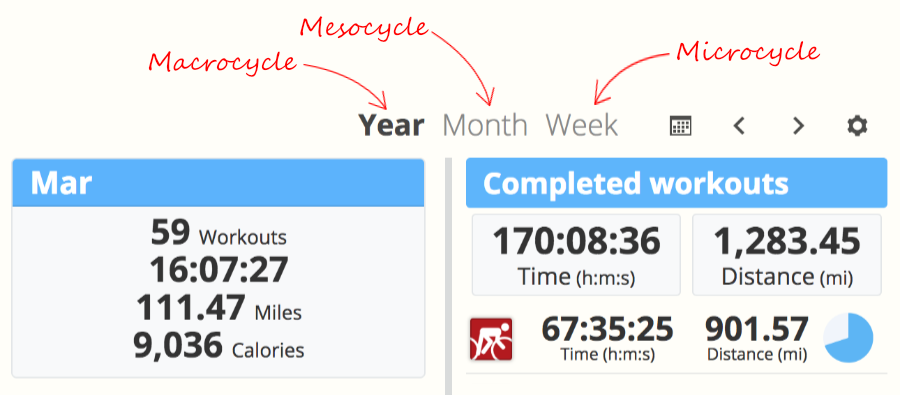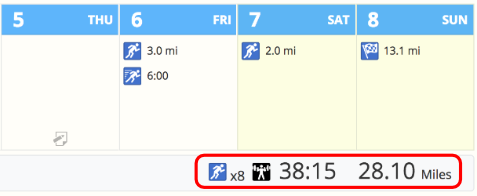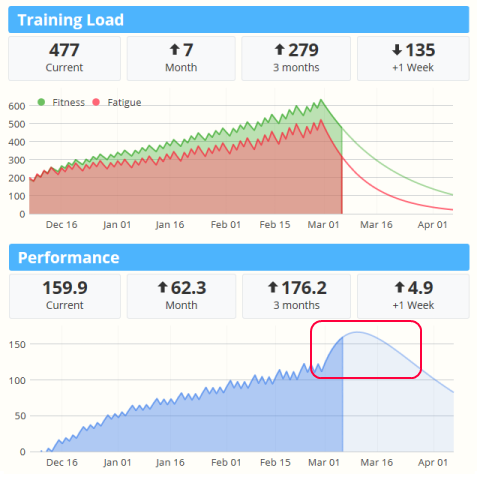Training with Periodization
Strategically plan your entire year to maximize performance
It's amazing that you can easily zero in on the minutia of a workout and identify important fitness indicators — like the moment your heartrate decouples — but if your goal is to achieve optimal performance, you must also zoom out and plot your entire racing season in advance. Many athletes and coaches achieve this with "periodization", the practice of strategically planning a full year. This enables your fitness to peak for a specific race, and it brings razor-sharp focus to every workout you do.
So, what's the best way to arrange your calendar to make the most gains? This topic has been hotly debated since the 1960's with no clear victor. With all of the variables to consider from athlete to athlete, it's easy to understand why. Putting the exact nuts and bolts aside, if you're not currently taking the whole year into consideration, there are benefits to be gained if you start doing so now.
The basics
With periodization, the year is split into blocks called macrocycles, mesocycles, and microcycles:
- Macrocycle: a 52-week block
- Mesocycle: 3 to 4 week blocks designed to train specific systems
- Microcycle: a 1-week block
Macrocycle
The macrocycle is your longview of the entire year. The idea is to choose your "A Race" (the most important race of the year) well in advance, and then plan to peak for it. You can fill the year with many other races leading up to and following this main event.
The macrocycle is split into three specific phases: preparation, competition, and transition. The most common approach is to use the preparation phase to work on base endurance, the competition phase is often focused on speed work and recovery, and the transition is your off-season, which can last any where from weeks to months.
Mesocycle
The mesocycle is a block of time that's dedicated to stressing a specific system. If a mesocycle stretches out beyond four weeks in endurance sports, it's often best to split it into two or more specific mesocycles, rather than a single phase. The goal is to make every workout count by avoiding wasted repetition. Over four weeks of the same regimen tends to produce diminishing returns compared to mixing it up.
Microcycle
While a microcycle only accounts for seven days (or fewer) of training, it should not be planned without considering the goals of the entire year. Depending on where it lands in your overall plan, a microcycle can be designed to stress a specific system, it could be a combination of stresses and recoveries, it could all be recovery, etc.
It should be noted that various levels of recovery are often included thoughout a plan, and are not reserved for pre-race tapering.

The not-so-basics
Now that you understand the framework of periodization, it's time to consider how to put it into play. This tends to be a rather complex topic that requires research for proper execution. With this in mind, be aware that it's best for your plan to remain somewhat simple at its core.
"Linear periodization" is the most common approach. Many training plans are organized linearly: the first mesocycles focus on building base endurance, then they move into speed and fast-twitch muscle stimulus, and lastly they feature recovery phases before the race. This likely sounds familiar.
"Nonlinear periodization" isn't as neatly separated. The idea is that instead of building up one system then stopping to focus on another, you keep all of them stimulated with consistent attention. This approach doesn't require months of work to arrive at peak fitness, but overtaining and injury become more of a threat.
There are many ways to approach periodization, with proponents and detractors of each. Spend some time considering what model appeals to you most, and start formulating a plan around it.
Work backwards
Once you've decided on your A Race, the next step is to begin planning your season in reverse. Start with the date of the A Race and fill in the mesocycles and microcycles in the weeks and months leading up to it.
If you're drafting the plan yourself, one option is to find a reputable and non-rushed training plan for your A Race, and adapt it to your SportTracks Calendar with the theories of periodization applied. This way you will be looking at your year on the whole, and you can start thinking about planning for the next year as well. Utilizing the Goal Tracking feature in SportTracks is another way to monitor your weekly, monthly, and annual progress.

SportTracks provides weekly and monthly totals to keep you on target
Planning an entire season is one area where experience truly pays off. While this is something you can do on your own (with the proper amount of research and care), it can more effectively be handled by a professional coach. This plan is going to shape your next 12 months and beyond, so it pays to have it crafted by a pro. Ask for recommendations for coaches from other endurance athletes, or use the Coach Search tool in SportTracks.
Don't ignore your Training Load
No matter who creates your training plan, you will have a solid idea of when your fitness will peak when you utilize the Training Load and Performance charts on your SportTracks Health page. They weigh your workout history against the workouts you have planned, and estimate your fitness and fatigue levels in the future. This way you can actually see when your future peak fitness will occur.

Periodization provides a clear and organized "big picture" plan that helps you stay on track, and more easily adjust in the event of injury and other setbacks. No one plans on catching the flu, but when you encounter a delay like this you can make slight adjustments to your planned workouts as needed, and check your Training Load and Performance charts to make sure you are still on target to peak.
Closely following a training plan is an excellent way to bring structure and purpose to your racing preparation, but if you don't consider what came before or after it, your fitness won't be as primed as possible. Utilizing the framework of periodization and the powerful tools in SportTracks is an excellent way to stay in top form, year after year.
| Learn more about this topic in our Reverse Periodization and Periodization Strategy articles. |
| Article written by Sam Mallery, Director of Marketing, Zone Five Software Inc. |

Comments
Is it possible to add something like an estimated total effort (TRIMP-based?) on planned workout? on the weekly summary? If it's possible to see the total effort for the weeks ahead, then a TRIMP-based periodization could be performed. Or is this already visible somewhere, I just haven't found it yet?
You can add Effort goals to planned workouts, as long as you have other goals in the workout that enable the calcuation of Effort to happen (such as a time goal). When you have multiple planned workouts with Effort, you can see how they influence your future fitness in the Performance chart on your Health page. You can contact support for more of walk-through on this process.